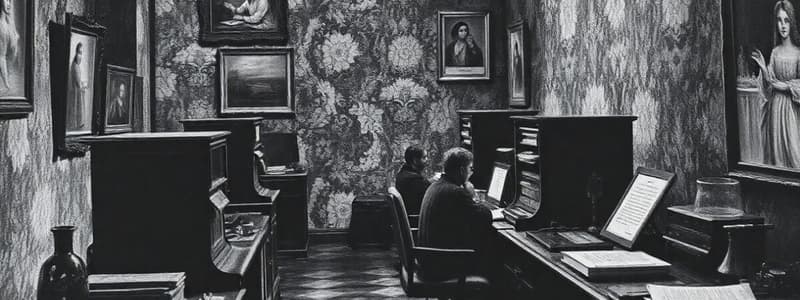Podcast
Questions and Answers
What does the statement 'All rights reserved' imply about the document?
What does the statement 'All rights reserved' imply about the document?
- It is owned and legally protected. (correct)
- It is outdated and no longer relevant.
- It can be freely distributed.
- It is only for internal use.
What does 'Protected until: None' indicate regarding the information's accessibility?
What does 'Protected until: None' indicate regarding the information's accessibility?
- The information has no protection and is publicly available. (correct)
- The information can only be shared internally.
- The information is always confidential.
- The information is available only for a limited time.
Who is identified as the author of the document?
Who is identified as the author of the document?
- Fuji Xerox Co., Ltd.
- TSD & R.Buenaventura (correct)
- Internal Use Only
- FXPI
What does the term 'Internal Use Only' suggest about the document?
What does the term 'Internal Use Only' suggest about the document?
When was the document prepared?
When was the document prepared?
Why is the phrase 'Fuji Xerox Internal Use Only' significant?
Why is the phrase 'Fuji Xerox Internal Use Only' significant?
What does the copyright notice imply about the content?
What does the copyright notice imply about the content?
Which of the following phrases indicates that there are no current confidentiality protections in place?
Which of the following phrases indicates that there are no current confidentiality protections in place?
What is the significance of the author noted in the document?
What is the significance of the author noted in the document?
What does the phrase "Protected until: None" imply about the document?
What does the phrase "Protected until: None" imply about the document?
What function does the lens serve as mentioned in the document?
What function does the lens serve as mentioned in the document?
What can be inferred about the date noted in the document?
What can be inferred about the date noted in the document?
What does the repeated mention of 'All rights reserved' signify?
What does the repeated mention of 'All rights reserved' signify?
What does the internal use only label suggest about the document's distribution?
What does the internal use only label suggest about the document's distribution?
In which segment of the document is the image projected?
In which segment of the document is the image projected?
What is implied by the term 'Protected' in the document?
What is implied by the term 'Protected' in the document?
What is the primary goal of the Basic Intake Course for ASP Engineers?
What is the primary goal of the Basic Intake Course for ASP Engineers?
Which of the following accurately describes a key difference between analog and digital processes in xerography?
Which of the following accurately describes a key difference between analog and digital processes in xerography?
What is a benefit of understanding the schematic diagram in machine analysis?
What is a benefit of understanding the schematic diagram in machine analysis?
What kind of knowledge will participants gain regarding the handling of the xerographic machine?
What kind of knowledge will participants gain regarding the handling of the xerographic machine?
Which of the following describes a key outcome of the course?
Which of the following describes a key outcome of the course?
Which statement best captures the overall intent of the Basic Intake Course for ASP Engineers?
Which statement best captures the overall intent of the Basic Intake Course for ASP Engineers?
Which aspect of xerography is emphasized for participants to understand?
Which aspect of xerography is emphasized for participants to understand?
What does the Basic Intake Course prepare participants to do?
What does the Basic Intake Course prepare participants to do?
Flashcards
Image Projection
Image Projection
The image is projected to the lens, a key part of the optical system in a camera or other image-capturing device.
Lens
Lens
A device that focuses and directs light, crucial for image formation in cameras.
Optical System
Optical System
A specialized component or system within a camera responsible for capturing light and forming an image.
Image Capture
Image Capture
Signup and view all the flashcards
Digital Image Formation
Digital Image Formation
Signup and view all the flashcards
Fuji Xerox
Fuji Xerox
Signup and view all the flashcards
Fuji Xerox Internal Use Only
Fuji Xerox Internal Use Only
Signup and view all the flashcards
Disclosed to
Disclosed to
Signup and view all the flashcards
Protected until
Protected until
Signup and view all the flashcards
Author
Author
Signup and view all the flashcards
Prepared on
Prepared on
Signup and view all the flashcards
© 2014 Fuji Xerox Co., Ltd.All rights reserved.
© 2014 Fuji Xerox Co., Ltd.All rights reserved.
Signup and view all the flashcards
Disclosed to: FXPI
Disclosed to: FXPI
Signup and view all the flashcards
Xerography
Xerography
Signup and view all the flashcards
Analog Process
Analog Process
Signup and view all the flashcards
Digital Process
Digital Process
Signup and view all the flashcards
Safe Handling
Safe Handling
Signup and view all the flashcards
Schematic Diagram
Schematic Diagram
Signup and view all the flashcards
Fault Isolation Procedure
Fault Isolation Procedure
Signup and view all the flashcards
Analyzing Machine Processes
Analyzing Machine Processes
Signup and view all the flashcards
Basic Intake Course Objective
Basic Intake Course Objective
Signup and view all the flashcards
Study Notes
Introduction to Xerography
- Xerography is a process used in many office machines like fax machines, printers, and copiers.
- It involves putting images on paper.
Inventor of Xerography
- Chester Carlson, a patent attorney, invented xerography in 1938.
Xerography Process Overview
- Xerox equipment and most copiers use a xerographic process.
- Laser printers also use this process.
- Plain paper fax machines also use this technology.
- The process knowledge serves as a base for understanding future Xerox-related subjects.
Basic Intake Course ASP Engineer Objectives
- Participants will understand xerography, its operations, and processes.
- Participants will learn the difference between analog and digital systems and their advantages.
- Participants will learn the basic procedures for safely handling the machine.
- Participants will be able to analyze machine processes using schematic diagrams and fault isolation procedures.
Photoreceptor Components
- Photoreceptor is the core of the machine.
- It receives, processes, and transfers images using static electricity.
- Most small copiers use a drum-type photoreceptor.
- Larger equipment uses a belt-type photoreceptor.
- The key ingredients are light-sensitive materials.
- A photoreceptor has four layers:
- Substrate: connects the photoreceptor to the ground, completing an electrical circuit.
- Oxide layer: connects the photoconductive layer to the substrate.
- Photoconductive layer: is affected by light. In darkness, it insulates, maintaining charge on the trapping layer.
- Trapping layer: stores the static charge.
Exposure
- When light hits the photoreceptor, the photoconductive layer becomes conductive (allowing current flow).
- This allows the charge on the trapping layer to flow through the oxide layer to the substrate.
- Where light doesn't hit, the charge remains. This creates a latent image on the photoreceptor, with charged and discharged areas.
Charging
- The photoreceptor is charged in darkness.
- The charge dissipates when exposed to light.
- A charge corotron places a uniform positive charge on the photoreceptor surface.
- Ionized air causes the air near the corotron to become positively charged.
- This positively charged air removes electrons from the photoreceptor, making it positively charged.
Developing
- Carrier beads carry toner to the photoreceptor. Carrier beads are heavier than toner.
- Toner is attracted to the carrier beads due to static electricity.
- Toner is negatively-charged
- A mixture of toner and carrier beads (developer) is created
- The magnetic brush or cascading process transfers developer to the photoreceptor.
- The output is a developed image on the photoreceptor, with toner attracted to the charged areas.
Transferring
- Paper is positioned over the developed image on the photoreceptor.
- Another corotron adheres the paper to the photoreceptor.
- Toner also strongly adheres to the paper.
- The toner on the paper is now transferred from the photoreceptor to the paper.
- The output is a copied image on the paper.
Fusing
- Toner still exists as a fine powder on the paper, and can be easily smudged.
- Heat and/or pressure melt the toner into the paper fibers.
- The output is a permanent image on the paper.
Cleaning
- The photoreceptor is cleaned to prepare for the next cycle.
- Residual charges and toner are removed to prepare to accept the new image.
- Two steps:
- Remove residual charges using AC corotron to neutralize positive charges on the photoreceptor as well as the negative charges on the residual toner
- Remove residual toner using a flexible cleaning blade
Digital Exposure
- Modern copiers, unlike printers, don't use hard copy originals.
- Copiers have an optical scanning device to convert images to digital information before digital-image processing.
- Data storage and easier document handling are benefits of digital exposure.
Color Xerography
- Color documents use a digitized method for the color copiers/printers
- The information controls the color filtering during exposure and the four developer housings
- Developer housings contain different color toners (magenta, yellow, cyan and black)
- Multiple cycles are required to generate a color copy
Studying That Suits You
Use AI to generate personalized quizzes and flashcards to suit your learning preferences.




